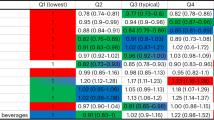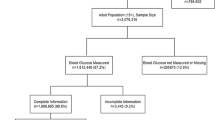Abstract
OBJECTIVE: To assess the frequency of different grades of nutritional status (obesity, overweight and thinness) in French children aged 7–9 y using four current definitions based on body mass index (BMI).
METHODS: Data were collected in 2000 in a randomly selected sample of French children following the protocol recommended by the European Childhood Obesity Group (ECOG). After computing the BMI (weight/height squared), four references were used to define grades of nutritional status: (1) the French references to define thinness and overweight (3rd and 97th percentiles respectively); (2) the Must et al references to define thinness, overweight and obesity (5th, 85th and 95th percentiles respectively); (3) the International Obesity Task Force cut-offs to define overweight and obesity; and (4) the Center for Disease Control 2000 references to define thinness, overweight and obesity (5th, 85th and 95th percentiles respectively).
RESULTS: Age and gender standardized frequencies were estimated in 1582 children. According to the French, Must et al, IOTF and CDC references, overweight (including obesity) affected 16.3, 23.9, 18.1 and 20.6% of children, respectively; obesity affected 9.3, 3.8 and 6.4% of children according to the Must, IOTF and CDC references, respectively. Thinness was present in 3.9, 6.0 and 6.0% of children according to the French, Must and CDC references. Whatever the definition, little difference was observed between sexes. Through age classes, as a rule, overweight and obesity tended to decrease while thinness tended to increase.
CONCLUSION: The present study revealed an increasing prevalence of overweight in comparison with previous French data and a trend for increasing prevalence of thinness. The IOTF-based prevalence of overweight (including obesity) in 2000 in France was similar with the prevalence recorded in the late 1980s in the USA and the prevalence of obesity in 2000 in France was similar to the prevalence of obesity in the late 1970s in the USA. Data in France are comparable to those reported in other studies conducted in Western Europe. This study provides baseline information for analysis of time trends and for geographical comparisons.
This is a preview of subscription content, access via your institution
Access options
Subscribe to this journal
Receive 12 print issues and online access
$259.00 per year
only $21.58 per issue
Buy this article
- Purchase on Springer Link
- Instant access to full article PDF
Prices may be subject to local taxes which are calculated during checkout



Similar content being viewed by others
References
Report of a WHO consultation on obesity. Preventing and managing the global epidemic WHO: Geneva 1998
Martorell R, Kettel Khan L, Hughes ML, Grummer-Strawn LM . Overweight and obesity in preschool children from developing countries Int J Obes Relat Metab Disord 2000 24: 959–967.
Bundred P, Kitchiner D, Buchan I . Prevalence of overweight and obese children between 1989 and 1998: population based series of cross sectional studies Br Med J 2001 322: 326–328.
Kromeyer-Hauschild K, Zellner K, Jaeger U, Hoyer H . Prevalence of overweight and obesity among school children in Jena (Germany) Int J Obes Relat Metab Disord 1999 23: 1143–1150.
Troiano RP, Flegal KM, Kuczmarski RJ, Campbell SM, Johnson CL . Overweight prevalence and trends for children and adolescents. The National Health and Nutrition Examination Surveys, 1963 to 1991 Arch Pediatr Adolesc Med 1995 149: 1085–1091.
Ryan YM, Gibney MJ, Flynn MA . The pursuit of thinness: a study of Dublin schoolgirls aged 15 y Int J Obes Relat Metab Disord 1998 22: 485–487.
Lehingue Y . The European Childhood Obesity Group (ECOG) project: the European collaborative study on the prevalence of obesity in children Am J Clin Nutr 1999 70: 166S–168S.
Rolland-Cachera MF, Deheeger M, Bellisle F, Sempé M, Guilloud-Bataille M, Patois E . Adiposity rebound in children: a simple indicator for predicting obesity Am J Clin Nutr 1984 39: 129–135.
Guo SS, Roche AF, Chumlea WC, Gardner JD, Siervogel RM . The predictive value of childhood body mass index values for overweight at age 35 y Am J Clin Nutr 1994 59: 810–819.
Freedman D, Kettel KL, Serdula M, Srinivasan S, Berenson G . BMI rebound, childhood height and obesity among adults: the Bogalusa Heart Study Int J Obes Relat Metab Disord 2001 25: 543–549.
Report of a WHO Expert Committee. Physical status: the use and interpretation of anthropometry WHO: Geneva 1995
Rolland-Cachera MF, Cole TJ, Sempé M, Tichet J, Rossignol C, Charraud A . Body mass index variations: centiles from birth to 87 years Eur J Clin Nutr 1991 45: 13–21.
Must A, Dallal GE, Dietz WH . Reference data for obesity: 85th and 95th percentiles of body mass index (wt/ht2) and triceps skinfold thickness Am J Clin Nutr 1991 53: 839–846.
Cole TJ, Bellizzi MC, Flegal KM, Dietz WH . Establishing a standard definition for child overweight and obesity worldwide: international survey Br Med J 2000 320: 1240–1243.
Kuczmarski RJ, Ogden CL, Grummer-Strawn LM et al. CDC growth charts: United States Adv Data 2000 314: 1–27.
Flegal KM, Ogden CL, Wei R, Kuczmarski RL, Johnson CL . Prevalence of overweight in US children: comparison of US growth charts from the Centers for Disease Control and Prevention with other reference values for body mass index Am J Clin Nutr 2001 73: 1086–1093.
Cole TJ . The LMS method for constructing normalized growth standards Eur J Clin Nutr 1990 44: 45–60.
Charles MA, Thomas F, Fontbonne A et al. Familial approach of cardiovascular risk factors: the ‘Fleurbaix Laventie Ville Santé’ study In: Woodford FP, Davignon J, Sniderman A (eds) Atherosclerosis X Elsevier Science: Amsterdam 1995 pp. 73–78.
Vol S, Tichet J, Rolland-Cachera MF . Trends in the prevalence of obesity between 1980 and 1996 among French adults and children Int J Obes Relat Metab Disord 1998 22 (suppl 3): s210.
Zimmermann MB, Hess SY, Hurrell RF . A national study of the prevalence of overweight and obesity in 6–12-y-old Swiss children: body mass index, body-weight perceptions and goals Eur J Clin Nutr 2000 54: 568–572.
Chinn S, Rona R . Prevalence and trends in overweight and obesity in three cross sectional studies of British children, 1974–94 Br Med J 2001 322: 24–26.
Cole TJ . Secular trends in growth Proc Nutr Soc 2000 59: 317–324.
Acknowledgements
We gratefully thank M Zarebska for her statistical assistance, Drs M Ambard, J Bonnisseau, AM Bouchard, S Donnadieu, E Lancelot, P Morel, I Ollier, V Onufryk, F Pelling, M Pradoura-Duflot, C Sainte Marie Perrin, AC Verchère, who helped in the organization of the study and the physicians and nurses who recorded the measurements.
Author information
Authors and Affiliations
Corresponding author
Rights and permissions
About this article
Cite this article
Rolland-Cachera, MF., Castetbon, K., Arnault, N. et al. Body mass index in 7–9-y-old French children: frequency of obesity, overweight and thinness. Int J Obes 26, 1610–1616 (2002). https://doi.org/10.1038/sj.ijo.0802146
Received:
Revised:
Accepted:
Published:
Issue Date:
DOI: https://doi.org/10.1038/sj.ijo.0802146
Keywords
This article is cited by
-
Prevalence of thinness and its effect on height velocity in schoolchildren
BMC Research Notes (2021)
-
Prevalence of obesity in Italian adolescents: does the use of different growth charts make the difference?
World Journal of Pediatrics (2018)
-
Levels of adiponectin and leptin at onset of type 1 diabetes have changed over time in children and adolescents
Acta Diabetologica (2015)
-
Prevalence of overweight and obesity in children aged 6–13 years—alarming increase in obesity in Cracow, Poland
European Journal of Pediatrics (2012)
-
Eleven‐year Prevalence Trends of Obesity in Greek Children: First Evidence that Prevalence of Obesity Is Leveling Off
Obesity (2010)



